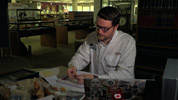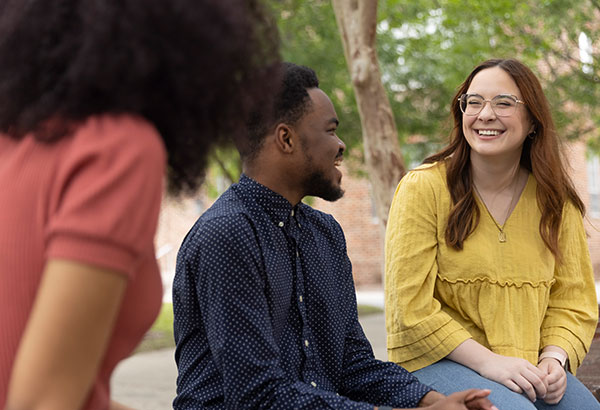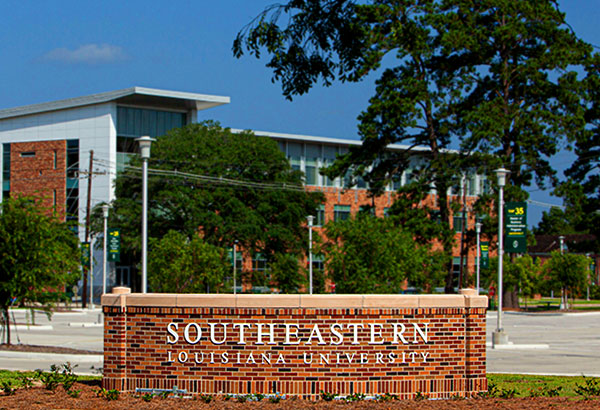New Southeastern Channel documentary highlights Manchac Swamp, Turtle Cove
Wednesday, July 17, 2019 
by: Tonya Lowentritt
RESEARCHING ARTIFACTS - Christian “Alex” White, a Southeastern history graduate student, is shown researching and recording artifacts discovered at Pass Manchac, some from over 3,000 years ago, at Southeastern’s Center for Southeast Louisiana Studies. The artifacts are included in the Manchac Swamp/Turtle Cove Artifacts Exhibit that appears at both the Center and at the Turtle Cove Environmental Research Station at Manchac. The artifacts provide documentation and evidence of the lifestyles and cultures of different inhabitants throughout the swamp’s history described in “Troubled Waters: Turtle Cove and the Manchac Swamp Ecosystem,” a new documentary produced by the Southeastern Channel. The program will air at 7:30 p.m. Wednesday, July 24, on the Southeastern Channel on Charter Spectrum 199 in Tangipahoa, Livingston, St. Tammany and St. Helena parishes and on the channel's website at thesoutheasternchannel.com.
HAMMOND – How history and science intertwine Manchac Swamp with Southeastern
Louisiana University’s Turtle Cove Environmental Research Station is highlighted by
a new display of swamp artifacts and new documentary produced by the Southeastern
Channel, Southeastern’s cable television channel.
“Troubled Waters: Turtle Cove and the Manchac Swamp Ecosystem” will air at 7:30
p.m. Wednesday, July 24, on the Southeastern Channel on Charter Spectrum 199 in Tangipahoa,
St. Tammany, Livingston and St. Helena parishes and via livestream at thesoutheasternchannel.com.
“The Manchac Swamp has played a prominent role in the history and culture of
the Northshore, and it continues to impact the lives of residents economically, recreationally
and environmentally with the protection it provides,” said Southeastern Channel General
Manager and executive producer of the show Rick Settoon. “It’s important for generation
after generation to know its history. This documentary is a powerful, educational
tool that shows what the Manchac Swamp was, what it is now, how it got to this point,
and what’s being done about it.”
The documentary’s story of the swamp begins with its earliest indigenous inhabitants,
Native Americans, and the earliest Europeans, 16th century French settlers led by
the explorer D’Iberville, Settoon said. It follows the swamp’s role and involvement
in conflicts from the French and Indian War to the West Florida Revolt and finally
the Civil War.
“The fact that it was such an enormous and impenetrable, forested wetland that
served so many different peoples and their cultures and helped serve the purpose of
many of their livelihoods makes it an extraordinary part of our history in this region,”
said Rob Moreau, director of Southeastern’s Turtle Cove Environmental Research Station
and the show’s producer and narrator.
The program also reveals the post-Civil War industrialization and exploitation
of the Manchac Swamp, including its eventual decimation by the cypress logging industry
and cypress-eating nutria.
“The Manchac Swamp is a changed ecosystem vastly degraded from what it once was,
a marsh now that is moving further towards open water instead of a dense cypress forest
that is of highest ecological value,” Moreau said.
The program spotlights artifacts recovered from Pass Manchac that have been assembled
into new exhibits at both Southeastern’s Center for Southeast Louisiana Studies in
Sims Library and Turtle Cove, which continues to conduct scientific research and collect
critical data from the coastal wetlands, along with managing swamp cleanup and reforestation.
The artifacts include arrowheads, pottery and tools used by the earliest inhabitants
to survive in the swamp. There are also Civil War items, maps, and leases along with
saw blades, timber tools, and photographs of sawmills and massive cypress trees representing
the magnitude of the swamp’s destruction during the logging years of the 1800s through
the mid-1950s.
“The artifacts shown in the film and the two physical exhibits represent and
bring into focus the human interaction with this natural environment,” Moreau said.
“A big part of the history of the Manchac Swamp is the ultimate devastation brought
upon it by humans. This provides a strong incentive moving forward for current and
future generations to be better stewards of not only the Manchac Swamp, but our global
environment as well.”
Settoon said “Troubled Waters” features historical drawings, archival photographs
and footage of the Manchac Swamp from centuries past, including old black-and-white
film of the early stages of the cypress logging industry with workers chopping down
cypress trees and transporting them via pull-boat barges and rafts through the swamp
to sawmills.
The program uses 3D and traditional animation techniques to bring to life scenes
from different periods throughout the swamp’s history and includes interviews with
Center for Southeast Louisiana Studies Director Sam Hyde, retired Southeastern History
Professor Charles Dranguet, Turtle Cove Caretaker Hayden Reno, Southeastern Development
Board Member Mike Sharp, and Entergy Director of Environmental Strategy Rick Johnson.
The documentary was written, directed and edited by Southeastern Channel Operations
Manager Steve Zaffuto.
“It was very important to link these unique artifacts to the surprisingly rich
history of the Manchac area,” Zaffuto said. “Through the use of interviews, location
videography and a few animated sequences, we were hopefully able to identify Turtle
Cove as not only a vital center of environmental research, but also an interactive
historical landmark.”
The show presents footage of educational activities, public outreach, scientific
research and swamp restoration efforts at Turtle Cove along with the artifact collection
being assembled and then unveiled at a Turtle Cove fundraising event.
“We like to think of ourselves as ‘stewards’ of the wetlands and as the ‘public
voice’ of Manchac and all that it is - past, present and future,” Moreau said of his
Turtle Cove operation.
The artifacts were obtained from the Center for Southeast Louisiana Studies,
including the Wiley H. Sharp, Jr. Collection of Southeastern Indian Artifacts. Mike
Sharp, retired Hammond banker and brother of the late Wiley Sharp, Jr., suggested
that the artifacts be organized into an exhibit at Turtle Cove to display the findings
and help explain the history of the region. The display was unveiled at a fundraising
event to support Turtle Cove’s operation and environmental restoration efforts.
“We are losing an enormous amount of acreage every year to storm surges, saltwater
intrusion, pollution, and a variety of other factors, and these swamps and marshes
provide barrier island protection from storms,” Sharp says in the documentary. “We
want to educate the public in terms of the importance of research and the preservation
and conservation of our priceless hardwood bottomland swamps and marshes.”






